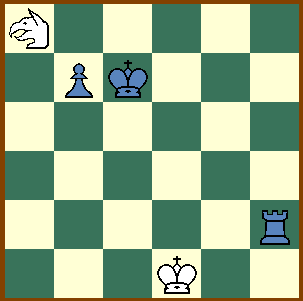Piececlopedia: Griffon
Historical Notes

The original use of the Griffon is in the game Grande Acedrex. This game is described in Libro del Acedrex, a game book that dates from 1283 under Spanish King Alphonso the Tenth.
John Williams-Brown uses the piece in his Meta-Chess book, although he uses a slightly more limited version (see below). He also suggests the name Hippogriff (described below) for a historical piece similar to the Griffon which was called the Giraffe.
Ralph Betza discusses the piece in his article on Bent-Riders.
For his game RennChess Eric Greenwood invented a more powerful piece called the Cavalier which is derived from the Griffon.
Note that in the English language, Griffin and Gryphon are also accepted spellings for Griffon.
Movement
The Griffon moves one square diagonally in any direction, then continues away from the starting square in an orthogonal direction. Its path must be unoccupied; it can not jump over pieces. It captures an enemy piece by moving onto the square occupied by that piece.
According to Pritchard, Gollon, Chessvariants, and Betza the Griffon can end its move on a diagonally adjacent square. The version used by Williams-Brown does not allow this - the Griffon passes over diagonally adjacent square, which much be unoccupied, and can only stop on subsequent orthogonally adjacent squares.
Movement Diagram
In the diagram below, the griffon can move to any of the squares marked by a red circle. The griffon could also capture any piece that occupied one of these squares.

Remarks
In general, the Griffon is a powerful piece that is more effective in the endgame where it has more open space to move. Williams-Brown notes that the Griffon has asymmetrical-retreat properties; in other words, when a Griffon moves from point A to point B, a subsequent move from point B back to point A will inevitably be along a different path, which may be blocked. On a crowded board the Griffon may be easily trapped.
In the diagram below, white has just moved his Griffon from e5 to a6. But the path back from a6 to e5, or any other safe square, is blocked by the black pawn on b5. If black plays Rf6, the best white can get for his Griffon is the Pawn, and black wins the game.

A Griffon and a King can force checkmate a lone King, although the procedure requires some thought. After the lone King is forced to the side of the board, the Griffon must make a 'waiting' move - similar to the one made by the Rook in a K and R vs. K endgame - so that his King can get opposition to the lone King. A slight difficulty arises in the fact that the Griffon must always move to a different file or rank. If a Griffon has the lone king trapped on the first rank for example, the Griffon must make a waiting move by moving from the first rank to the third, or vice-versa.
You can practice checkmating a bare King with a Griffon here.
The Hippogriff
The Hippogriff originally appeared in the historical game Tamerlane Chess, where it was called the Giraffe. Giraffe, however, is already commonly used for another piece; John Williams-Brown suggested the name Hippogriff. The Hippogriff moves the same way as the Griffon, except that it must move at least three squares orthogonally after the initial diagonal move. (The Hippogriff is in fact similar to the Giraffe in that the closest squares it can move to are the same as those that the Giraffe would move to; the Hippogriff can almost be thought of as a combination of the Giraffe and Griffon, although it does not leap other pieces like the Giraffe does.)
In the diagram below, the Hippogriff can move to any of the squares marked by a large red circle, but not to any of the squares marked by a small red circle. The small-circled square must be unoccupied or the else the pieces on those squares - friendly or enemy - will block the path of the Hippogriff in that direction.

The Hippogriff is a much weaker and more awkward piece than the Griffon. Note, for example, that a Griffon on an 8x8 board can move to more squares than a Hippogriff on a 12x12 board, and requires at least three moves to get to a diagonally adjacent square. On an 8x8 board, the shortest path for a Hippogriffon to get from a1-b2 is by the route a1-b5-f6-g1-b2 .
This is an item in the Piececlopedia: an overview of different (fairy) chess pieces.
Written by Benjamin C Good.
WWW page created: March 13, 2002.
